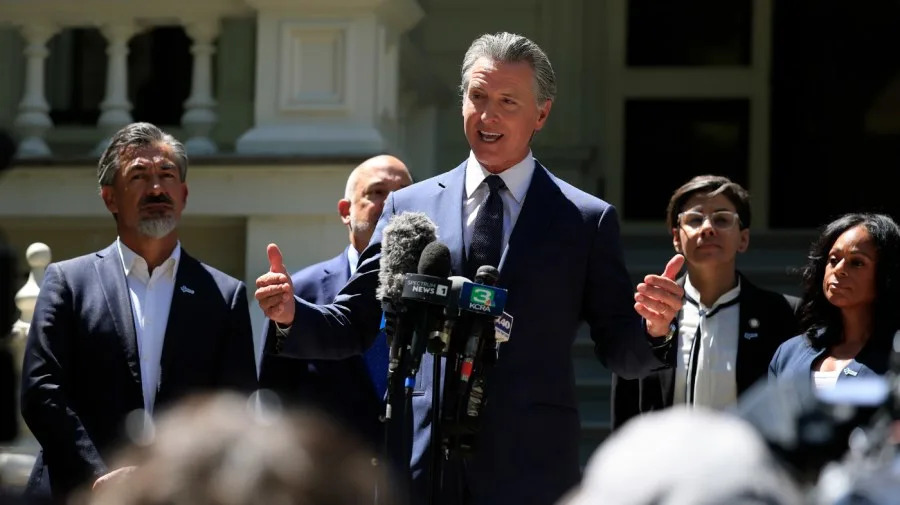
With the latest fight over tit-for-tat redistricting efforts, Democrats continue to play right into President Trump and Republicans’ hands, at the expense of their own viability.
Put another way, moves by California and New York, as well as potentially Illinois, are understandable in the context of Democrats trying to counter Republicans’ redistricting efforts in Texas and preserve their chances to retake the House. But they are missing the bigger problem.
Indeed, by prioritizing this fight, voters are still not hearing a middle-of-the-road message from the Democratic Party that offers an alternative to President Trump and the Republicans.
As such, whereas voters hear Trump and Republicans fighting for smaller government, lower taxes and deregulation, there is no Democratic alternative. This leaves Americans to continue wondering what this Democratic Party is fighting for.
To be sure, Democrats’ problem is self-made rather than weakness in the face of an overwhelmingly popular president.
According to Wall Street Journal polling, Trump’s approval rating is 6 points underwater (46 percent approve and 52 percent disapprove). Moreover, voters disapprove of Trump’s signature legislation, his “big, beautiful bill,” with Kaiser Family Foundation polling showing nearly two-thirds (63 percent) hold an unfavorable view.
And yet, during the debate over this bill, congressional Democrats made noise in opposition to large-scale cuts to social and healthcare programs without offering a coherent agenda or alternative.
And although Trump’s approval rating is underwater, it is better than the record-low ratings voters give Democrats. The party’s net favorability rating, minus-30 points (33 percent to 63 percent) in the Wall Street Journal poll, is just the latest example of the party polling at its lowest numbers in decades, if not since polls began asking about party favorability.
To have any chance of taking at least one chamber of Congress, Democrats need a new agenda, one that includes bold new positions on key issues: immigration, the economy, education, and energy policy.
First, on immigration, arguably where Democrats struggle the most, there must be a middle ground approach.
The compromise should be a program that starts with enhanced border security, prevents criminals from entering the country, and, once those are implemented, creates a pathway to citizenship.
Americans want a secure border, along with vetting those who enter the country. At the same time, voters also recognize the benefits of legal immigration and believe a pathway to citizenship must exist.
To that point, Americans overwhelmingly (85 percent) support allowing DREAMers a chance to become citizens, while a similar 78 percent also support allowing undocumented adults a pathway to citizenship, provided they meet certain requirements, per Gallup polling.
Simultaneously, more than 6 in 10 (62 percent) disapprove of Trump’s heavy-handed tactics of removing even law-abiding undocumented immigrants, underscoring the opening for Democrats to present a credible alternative.
The next priority must be the economy.
Quite simply, if Democrats want to bring working-class voters back into the fold, there needs to be a new approach to economic policy.
In the 2024 election, a majority (53 percent) of voters trusted Trump rather than Kamala Harris (46 percent) to handle the economy according to CNN exit polls, and this gap in trust has gotten worse.
According to the aforementioned Wall Street Journal poll, even though a majority (53 percent) disapproved of Trump’s economic policies, voters also trusted Republicans over Democrats on the economy by 12 points (39 percent to 27 percent).
That striking finding highlights the depth of Democrats’ problems, as well as their need to formulate a new economic policy.
In doing so, Democrats should take care to avoid the platform that Zohran Mamdani rode to victory in New York City’s Democratic mayoral primary.
As a self-professed Democratic Socialist, Mamdani’s policies are considerably out of touch with America’s capitalist roots, and even what mainstream Democrats want.
His promises of endless handouts backed by huge tax increases are more than bad economic policy, they are politically toxic in a national election.
In that same vein, rather than hiking taxes to fuel an ever-expanding government, Democrats should come up with their own version of the Department of Government Efficiency.
Both Republicans and Democrats understand that the federal government is bloated and inefficient, and while Elon Musk led DOGE in a haphazard manner, that should not preclude Democrats from offering their own version of spending cuts.
However, Democrats can, and must, develop an economic agenda that protects the social safety net and key social and healthcare programs, but does so in a fiscally prudent manner.
The third issue where Democrats must present a new agenda is their approach to energy and climate policy.
Reducing carbon emissions is a worthy goal, but Democrats should balance environmental concerns with the very-real fact that Americans, especially working-class voters, do not want to pay sky-high prices for energy.
By acknowledging the need for an all-in energy policy that is grounded in reality, the country still needs fossil fuels and domestic drilling while it invests in renewable energy technology, Democrats can both advance climate goals and keep prices low.
Finally, on education, this new Democratic agenda should focus on giving parents the freedom to choose which schools their children attend, including charter schools.
For years, school choice has been anathema to Democrats, but the party will have to find a way to promote school choice without robbing resources from public schools.
Simply curtailing the assault on charter and gifted schools, often driven by far-left politicians like Mamdani, would help restore parents’ trust in the Democratic Party.
Ultimately, Democrats find themselves at a crossroads: out of power, out of favor with broad swaths of the electorate and able to mount only performative protests against Trump and the Republican Party.
The last time Democrats were in this position in the 1980s and early 1990s, the centrist, forward-looking agenda put forward by former President Bill Clinton pulled the party out of the political wilderness.
It will take a similarly middle-of-the-road agenda to save Democrats today, and they can start with the above.
Douglas E. Schoen and Carly Cooperman are pollsters and partners with the public opinion company Schoen Cooperman Research based in New York. They are co-authors of the book, “America: Unite or Die.”
Copyright 2025 Nexstar Media, Inc. All rights reserved. This material may not be published, broadcast, rewritten, or redistributed.
For the latest news, weather, sports, and streaming video, head to The Hill.


Comments